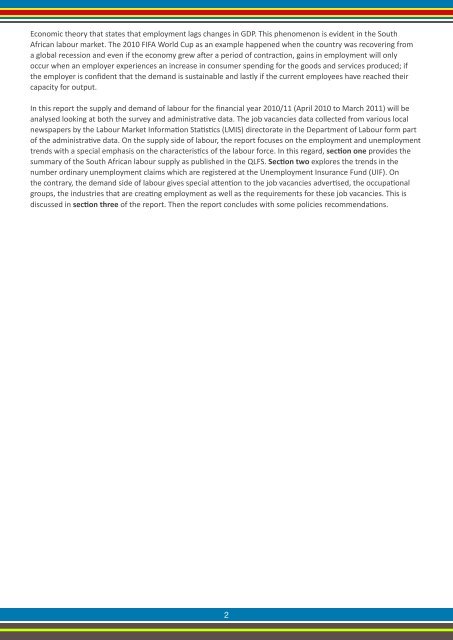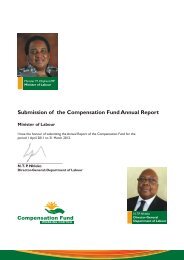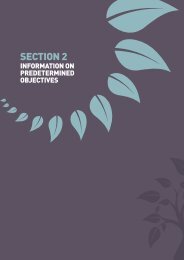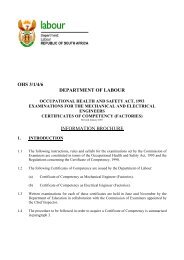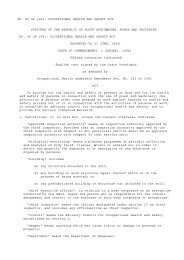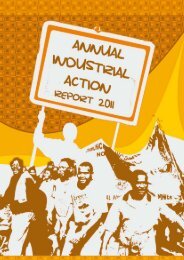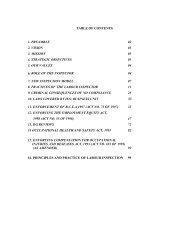IntroductionThe dilemma in the South African labour market is to find the right balance between high levels <strong>of</strong> unemployment<strong>and</strong> the shortage <strong>of</strong> certain skills as dem<strong>and</strong>ed in the economy. Several researchers have reported that theSouth African labour market needs skills ranging from managers <strong>and</strong> pr<strong>of</strong>essionals to artisans. This has alsobeen identified in Accelerated <strong>and</strong> Shared Growth Initiatives for South Africa 1 (Asgi - SA) as one <strong>of</strong> the bindingconstraints to improve the South African economy to 6% growth per annum between 2010 <strong>and</strong> 2014. Then thequestion is what should be an acceptable level <strong>of</strong> the state intervention to attract workers into the South Africanlabour market? In other words, if the economy is considered as a whole, one can argue that a higher real wage canencourage a higher participation rate.Recently, many South Africans had high expectations with regard to the labour market outcomes in the country.With the 2010 FIFA Soccer World Cup being hosted on South African soil, many people expected the World Cupto produce a positive economic impact <strong>and</strong> other associated benefits in terms <strong>of</strong> employment <strong>and</strong> businessopportunities especially the Small Medium Enterprises (SME’s). For South Africa as a country, the 2010 FIFA SoccerWorld Cup was to act as a catalyst for economic growth <strong>and</strong> the achievement <strong>of</strong> development goals. This was inlinewith the perceptions <strong>of</strong> South Africans according to a survey conducted by the Human Sciences Research Council(HSRC) in 2007. About 50% <strong>of</strong> the people perceived economic growth <strong>and</strong> job creation to be the two main benefits<strong>of</strong> hosting an event <strong>of</strong> such magnitude.Sports economist Preuss 2 , stresses a number <strong>of</strong> objectives that host countries gain when hosting events <strong>of</strong> thisnature. These include: putting the country ‘on the map’, showcasing the region, promoting the political system,creating new trading partners, attracting investment, boosting tourism, creating jobs <strong>and</strong> business opportunities,urban renewal (including housing <strong>and</strong> infrastructure) <strong>and</strong> building a legacy <strong>of</strong> sports infrastructure.To track the benefits <strong>of</strong> the 2010 FIFA World Cup on economic growth <strong>and</strong> employment, one has to look atthe Gross Domestic Product (GDP) <strong>and</strong> the Quarterly <strong>Labour</strong> Force Survey (QLFS) figures both produced <strong>and</strong>published by Statistics South Africa. The data shows that although there was positive economic growth, it was notaccompanied by a large number <strong>of</strong> people being employed. The quarter two GDP figures shows that growth slowedto 3.2% from 4.6% in quarter one <strong>of</strong> 2010. This was accompanied by a decline <strong>of</strong> 61 000 in employment. Growthfurther slowed down to 2.6% in quarter three <strong>of</strong> 2010, with employment declining by 86 000 in the same quarter. Inquarter four <strong>of</strong> 2010, the GDP strengthened sharply to 4.4% <strong>and</strong> this was accompanied by massive job gains(157 000). In quarter one <strong>of</strong> 2011, the economy strengthened further by 4.8% but employment decreased by14 000 in the same quarter.From this, one might have expected employment to start increasing in quarter two due to the activities <strong>of</strong> theWorld Cup, in particular in construction industry but that was not the case as the jobs were relatively realised inquarter three (July) <strong>of</strong> 2010. Although there were some employment opportunities in some industries like trade(restaurants, hotels, etc), tourism, finance (travel services <strong>and</strong> short-term insurance) <strong>and</strong> community <strong>and</strong> personalservices especially for security measures these jobs were not sustainable jobs as these jobs were shed after theWorld Cup. In terms <strong>of</strong> business opportunities, the informal sector was the most beneficial sector although it doesnot contribute much in the overall GDP.1This intervention aimed to raise the level <strong>of</strong> skills in areas needed by the economy through a range <strong>of</strong> programmes in both education <strong>and</strong>skills development.2 Preuss, H. (2000), Economics <strong>of</strong> the Olympic Games - Hosting the Games 1972-2000, Walla Walla Press in conjunction with the Centre forOlympic Studies.1
Economic theory that states that employment lags changes in GDP. This phenomenon is evident in the SouthAfrican labour market. The 2010 FIFA World Cup as an example happened when the country was recovering froma global recession <strong>and</strong> even if the economy grew after a period <strong>of</strong> contraction, gains in employment will onlyoccur when an employer experiences an increase in consumer spending for the goods <strong>and</strong> services produced; ifthe employer is confident that the dem<strong>and</strong> is sustainable <strong>and</strong> lastly if the current employees have reached theircapacity for output.In this report the supply <strong>and</strong> dem<strong>and</strong> <strong>of</strong> labour for the financial year 2010/11 (April 2010 to March 2011) will beanalysed looking at both the survey <strong>and</strong> administrative data. The job vacancies data collected from various localnewspapers by the <strong>Labour</strong> Market Information Statistics (LMIS) directorate in the <strong>Department</strong> <strong>of</strong> <strong>Labour</strong> form part<strong>of</strong> the administrative data. On the supply side <strong>of</strong> labour, the report focuses on the employment <strong>and</strong> unemploymenttrends with a special emphasis on the characteristics <strong>of</strong> the labour force. In this regard, section one provides thesummary <strong>of</strong> the South African labour supply as published in the QLFS. Section two explores the trends in thenumber ordinary unemployment claims which are registered at the <strong>Unemployment</strong> Insurance Fund (UIF). Onthe contrary, the dem<strong>and</strong> side <strong>of</strong> labour gives special attention to the job vacancies advertised, the occupationalgroups, the industries that are creating employment as well as the requirements for these job vacancies. This isdiscussed in section three <strong>of</strong> the report. Then the report concludes with some policies recommendations.2


